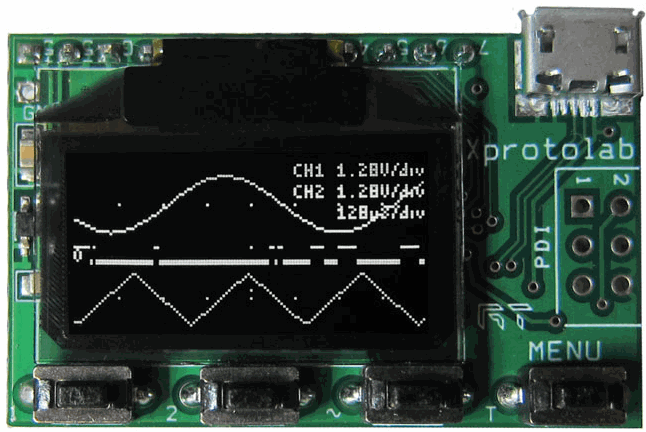Xprotolab Scope Review, by Jack Ganssle (Reviewed April, 2011)
I found a new scope that completely flabbergasted me. It's an unexpected but natural outgrowth of the same embedded upheaval that will shape robotics. The Xprotolab from Gabotronics (http://www.gabotronics.com/development-boards/xmega-xprotolab.htm) seemed at first the product of a Soma-induced hallucination.

Forty nine bucks a pop. $35 each if you buy 10. That's not a misprint. To my knowledge it's the cheapest scope on the market. And it includes a display; this is not one of those USB dongles that digitizes data and passes the results to a PC application.
It's 1" x 1.6", or about the size of two postage stamps. Did I mention there's a display? That's included in this form factor.
Then there's the feature set. The Xprotolab implements most of the features of a modern scope. This is even a mixed-signal scope: it has two analog channels and 8 digital. It'll compute FFTs, and has an arbitrary waveform generator (which can run in the background while the scope is being used). There's a DMM and frequency meter as well, cursors, all of the usual triggering options, and some math capability. There's a protocol sniffer, but since my unit's firmware was old I couldn't test that feature.
Did I mention it's $49?
The unit has plenty of limitations, of course. It has a 200 kHz analog bandwidth with a max sampling rate of 2 MSPS. The buffer size is just 256 bytes per channel, and the input voltage range ±20V. The screen update rate runs around warp 0.00001; it redraws the traces about once per second. This is not a substitute for a lab scope.
Modern oscilloscopes tout their large screen sizes. Bigger is better. The Xprotolab's display is a bit smaller than a wide-screen TV. It's 0.9". I thought about putting a magnifying glass in front of it, as people did for the tiny displays used on the first televisions. It's frankly hard to read, at least for the bifocaled, though the OLED display is very bright and crisp. The scope's astoundingly small size mandates a lot of squinting. But it is indeed readable. With 128 x 64 pixels there's some distortion of signals; square waves may have a bump in the rising and trailing edges.
Just four (tiny!) momentary switches control all of the scope's modes. There's a brilliant menuing system to select and change parameters. On a lab scope a quick twist of the wrist selects a sweep rate or amplitude setting; on Xprotolab you'll have to click a few - or sometimes more than a few - times to set things up, but with practice it's pretty easy to control.
This Lilliputian scope will plug directly into a prototyping board, but it cries out to be integrated into a product. I can see including it in an instrument to show the data being collected. Or as a tuning indicator for a radio. Maybe a weather station barograph or an energy consumption monitor. The possibilities are endless. The scope is sort of marketed as a development platform. With the code and development tools all available it's an easy matter to tune it to your application.
Way cool

